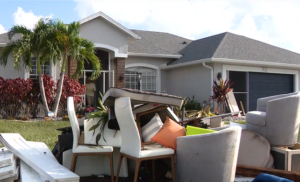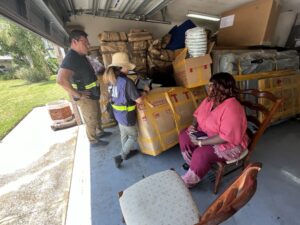Many Floridians caught without flood insurance

Waterlogged furniture sits curbside in the Laurel Meadows neighborhood of Sarasota following flooding from Hurricane Debby, August 9, 2024. Courtesy, WTVT-TV Fox 13
The latest Florida damage estimates will be released later today but as of last Wednesday, Hurricane Debby’s insured losses had grown to $113.8 million on 15,326 claims for a storm that may total up to $2 billion in insured losses along the eastern seaboard. As anticipated, it was much more of a rain/flood event than a wind event (maximum winds were 80 mph), but with surprising inland flooding here in Florida. Three traffic deaths were blamed on the Category 1 storm that made landfall on August 5 near Steinhatchee in rural Taylor County, just a few miles south of where Hurricane Idalia made landfall last August. President Biden declared 10 counties as major disaster areas (Columbia, Dixie, Gilchrist, Hamilton, Lafayette, Levy, Manatee, Sarasota, Suwanee, and Taylor) allowing FEMA assistance for home repairs, low-cost loans to cover uninsured property losses, and other recovery programs.

A pickup truck is overcome with flood waters in a Bradenton neighborhood from Hurricane Debby, August 5, 2024
About 9,400 of the Florida claims so far are residential property, with the bulk of the rest (up to 5,400) being automobile. Flooding was the big issue, especially inland, not only from landfall, but along the way in Pinellas, Manatee and Sarasota counties. Entire inland neighborhoods, such as Laurel Meadows in Sarasota County, were flooded. One of those homeowners, Daniele Mion-Bet, told Fox 13 Tampa, “I think about 90-95 percent of the community has no flood insurance talking to neighbors. And obviously this is not a $10,000 or $20,000 cleanup especially nowadays with inflation. When they tell us you don’t have to worry about flood insurance because you are in a 500 year, 0.2% flood area, and now I have to do it because I should have,” he said. I was interviewed as part of this story and others over the last two weeks, and talked about this “cold, hard reality,” urging again that all Florida residents need to consider purchasing flood insurance, regardless of their FEMA zone, as all homeowners policies clearly state “This policy does not cover flood.”

A flooded kitchen in the Laurel Meadows neighborhood of Sarasota from Hurricane Debby, August 5, 2024. Courtesy, WTVT-TV Fox 13
The 12 to 18 inches of rain Debby dumped on parts of Florida continued along its path across Georgia, the Carolinas, and into the Northeast U.S. Although deeming it a “very manageable event” for insurance companies, Gallagher Re’s analysis puts total insured losses for now at between $1 billion to $2 billion, which includes National Flood Insurance Program claims. (That’s comparable to Hurricane Idalia’s $1.4 billion mainland losses.) Total economic losses, including uninsured losses, could be “far higher” due to flood damage.
“While coastal counties in Florida, Georgia, and South Carolina have National Flood Insurance Program take-up ranging from 10% to 50%, the percentage of active policies drops dramatically once inland,” according to the analysis. “This means a sizeable portion of flood damage is likely to be uninsured.”
After Debby’s landfall, the Florida Department of Financial Services issued a consumer alert, reminding homeowners that Assignment of Benefits (AOB) contracts are illegal in Florida. CFO Jimmy Patronis also issued an Emergency Order, effective through October 6, that:
- Extends the time consumers have to cancel a public adjuster contract from 10 days from the date the contract is executed to 30 days now (or 30 days from the date of loss, whichever is longer);
- Clarifies that any adjuster working with a consumer on behalf of an insurance company is subject to the 7-day “review and respond to customer inquiries requirement;” and
- Requires persons acting as adjusters to identify themselves and explain their role in the process when they interact with a consumer verbally, and not just in a written notice or advertising, as provided in law.

FEMA Disaster Survivor Assistance Teams are visiting Florida neighborhoods to help Hurricane Debby survivors complete their application for assistance, August 15, 2024. Courtesy, FEMA
Let’s remember that most of Debby’s Florida damage occurred when it was a Tropical Storm. So we need to take such storms seriously, too. Need further proof? Even heavy rainstorms require flood insurance, as the latest claims report on the mid-June Invest 90L flash flooding in Miami-Dade and Broward Counties has so far resulted in estimated insured losses of $90.4 million.
Meteorologists warn this especially warm moist air will stick around for now, increasing flood risk, and further supporting previous predictions of a well above average hurricane season, with the height of hurricane season (September 15 to October 15) still ahead of us. Please be safe and prepared!
LMA Newsletter of 8-19-24

